
Features
Crops
Flowers
Growing in the Green: Testing garden performance
November 2, 2011 By Melhem Sawaya
Even though it was a very hot summer, most of the 2,300 varieties
performed very well during the 11th annual Sawaya Garden Trials. The
heat-loving varieties gave visitors an especially rewarding show.
(Umbrellas were used to ward off the sun, rather than protect against
the rain.)
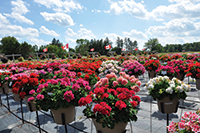
|
|
| This was the 11th year for the trials, located near Simcoe, Ontario.
|
Even though it was a very hot summer, most of the 2,300 varieties performed very well during the 11th annual Sawaya Garden Trials. The heat-loving varieties gave visitors an especially rewarding show. (Umbrellas were used to ward off the sun, rather than protect against the rain.)
There were very few rainy nights, and fortunately most of the days were still sunny and hot. It is amazing how fast the recovery is for some plants, and how there is virtually no setback for them at all, while others look like they went through the “heavy duty” cycle in the washing machine.
These weaker varieties take five to seven days to recover – mainly from shattered flowers – with Botrytis getting hold of the rest. Surprisingly, many of the varieties that are not supposed to take extreme heat actually did very well, including osteospermum and lobelia; the flowers lasted a very long time.
My conclusion, based only on personal observations, is that flower longevity is related to the average temperature. Generally speaking, the higher the temperature, the shorter the flowering time; however, if plants are outside in full sun and watered well, flower power and strength is much better even under high temperatures. Having said that, it is still true that the higher the temperature, the weaker the flower life cycle, especially when light levels are low or the crop is overly shaded. That is why most plants – if not all – flower better and enjoy a longer flower life cycle when they’re outdoors in full sunlight rather than in the shade.
The main purpose of Sawaya Garden Trials is to see the varieties that perform best in our climate. For the past 11 years, we have seen some genera perform well and others not quite as well. Calibrachoa, for example, has increased in production by over 1,000 fold, not only in Ontario, but throughout Canada as well. This increase is due to its excellent garden performance, and the fine show it puts on from early spring to late fall as long as it is fertilized with every watering.
Ivy geranium in Ontario, in my experience, is a total loss as a garden performer. Hardly any of the regular types, from what I could tell, were produced; on the other hand, the interspecific varieties, such as Caliente and the balcony types, are on the increase. After all, we are growing plants for the ultimate consumer, and their success is our success.
Trial plants are donated and sold onsite by Norfolk General Hospital volunteers. Consumers are amazed by the quality of the plants, and are happy to pay $20 a pot for annuals, even on Aug. 20.
So why are gardeners not getting the full potential beauty out of their plants?
The answer is simple – we are not effectively communicating plant care information to the ultimate consumer. Unless we are planning to shrink our sales by 2.5 per cent every year, we’d better get together with retail buyers and other industry representatives and educate the consumer.
Here are some steps to increase our sales:
- Only grow the varieties we know will grow well in the garden.
- Sell the plants in larger containers than you are used to. For example, place flats material in much larger cells or 4” pots, and 4” material in 6” pots. The rule of thumb is that if you have to apply growth regulators more than once to make a plant fit, then the container is probably too small. This works well with dahlia, blue salvia, Profusion zinnias, African marigolds, and gazania, to mention only a few.
- Plant in a good potting media with no weird additives. Prolonging watering requirements provides a false expectation to the consumer.
- Top-dressing the containers with slow-release fertilizer could be a setback for varieties that cannot take a heavy dose of fertilizer at once and that will happen when we get high temperatures. Slow-release fertilizers are activated based on temperature and especially if the plants are not getting enough water on time.
- Provide free liquid fertilizer, as a bonus, when they buy your plants.
- If we don’t do anything else, we must sell simplified drip kits so the homeowner can water plants effectively and regularly. I guarantee that plant sales will increase three to four per cent every year rather than decrease by two to three per cent. I have first-hand experience with people who visit our trials. They often ask about our drip system and I tell them where to buy it and the simple steps needed to put it together. Those who do install the drip system make it a point to come back and thank me for the hint. They also tell me how they are going to buy many more plants because they know the plants are going to do well and without any more work.
- Get involved in advertising plants and their benefits.
- In this industry, there is no sitting on the fence. If we are not part of the solution, we are part of the problem.
Here are some highlights from our trials this hot summer. It is not practical or possible to share with you the performance of the 2,300 cultivars, so this year I decided to pick a few cultivars that were excellent performers while being drastically underproduced in the industry. Next month I will be sharing a few more cultivars, the top 10 performers and the ever-popular mixed container pots and hanging baskets contest winners.
Every year I hate geraniums for the simple reason that they require lots of deadheading, though this is mainly needed when it rains. Last summer was pretty much on the dry side for most the month of July in southwestern Ontario, so minimal deadheading was required and the blooms had a chance to grow larger and put on a great show.
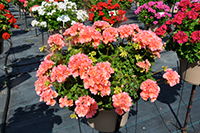
|
|
| 1
|
‘Trend Salmon’ (1) is a geranium variety that looked good with its zoned leaves, along with lots of flowers that last for a long time. It is excellent for 4”, 10” hanging baskets (HB), or larger pots.
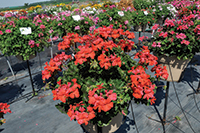
|
|
| 2
|
For the third season, ivy geranium hybrid Caliente series proved to be an excellent performer. ‘Caliente Orange’ (2) is one colour in this series that never stopped flowering the whole season. It is one of the few types of ivy geranium not susceptible to oedema during greenhouse production. Caliente is a vigorous series that can save production costs; only three cuttings can make a full 10” basket where other ivies require four cuttings.
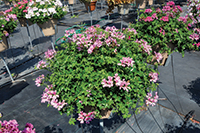
|
|
| 3
|
‘Tornado Bicolour Duet’ (3) is one colour of this seed-propagated ivy geranium series that performed exceptionally well. It works especially well in mixed containers.
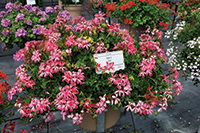
|
|
| 4
|
‘Acapulco Compact’ (4) is one colour in the Cascade ivy series that does very well in any weather and for the whole season. Using more of it will get the consumer to buy more plants next season. Cascades are especially effective in large hanging baskets.
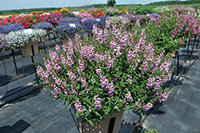
|
|
| 5
|
‘Serena Lavender’ angelonia (5) is one colour in this series that features excellent performance the whole summer and gets better with high temperatures. Rain does not hinder its ever-floriferous habit. Almost all angelonias flower the entire summer, but the Serenas maintain a nicer growing habit. Another advantage is that as a seed variety, it is a little more economical to produce and you don’t have to worry about shipping quality and availability. Angelonias are excellent landscape items. However, while they cannot stand cool weather in early spring, they can take cool weather at the end of the summer because they’ve become acclimatized. Angelonias could have a much larger share of the landscape market if marketed properly by emphasizing its excellent garden performance.
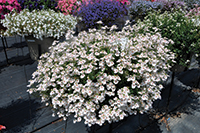
|
|
| 6
|
‘Darla Apple Blossom’ (6) is a nice colour of an excellent diascia series that blooms well into late summer before it picks up and gets even better in September. Diascia can be used in cool mixes that are sold in April and also in mixes with fall mums.
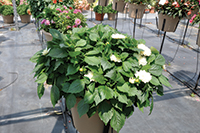
|
|
| 7
|
‘Hypnotica White’ (7) is one of many colours in this dahlia series. Hypnoticas are mainly used in 6” or gallon pots, or with mixes. Dahlia benefits from roots staying cool and lots of soil volume due to tuber formation, which is more prevalent in smaller pots. The plants do not grow to potential when tubers are being formed and that’s why dahlias do much better in landscapes rather than in containers.
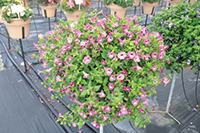
|
|
| 8
|
‘Summer Wave Large Amethyst’ (8) is still one of the better performers compared to other torenias. Summer Waves do very well in sun – but don’t let them dry out – and they also do well in semi-shady areas. Torenias are great in 10” HB and do very well in combinations that are grown for semi-shaded areas.
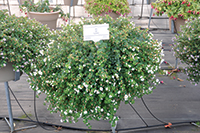
|
|
| 9
|
‘Scopia Gulliver White’ (9) is still one of the many excellent bacopa varieties on the market. Normally, bacopas in our trials do flower throughout hot summers except when we dry them up. Once that happens, it takes two weeks to regenerate a new flush of flowers… and unfortunately that is when I took the pictures. Bacopa is excellent in mixed containers, and in landscape beds where there’s not much chance of them drying out; the roots can go deeper to find moisture.
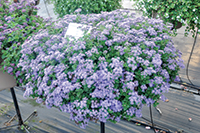
|
|
| 10
|
‘Artist Blue’ ageratum (10) has an excellent blue colour, a strong growing habit, and it flowers well into the frost season. It is easy to grow and requires no deadheading. It is excellent in hanging baskets and is good to experiment with in some mixes.
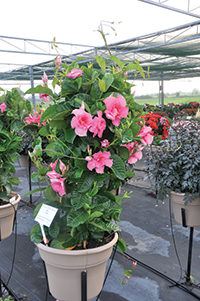
|
|
| 11
|
‘Super Trooper’ mandevilla (11) is a double pink flower that puts on a very nice show in pots or landscapes or high-end combinations. Unfortunately, the production time is long and it only flowers under long days, and warm – if not hot – conditions. Buying mandevillas from Florida in gallon pots and upgrading them into larger pots or mixes to finish growing is more likely to make economic sense.
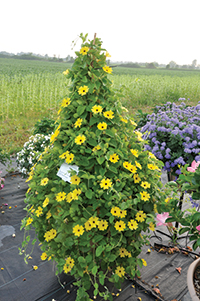
|
|
| 12
|
Who doesn’t want a plant that looks like the ‘Lemon Thumbergia’ (12) that flowers the whole summer long and grows so well. Make sure to fertilize and water and it will provide a great show until a mild frost.
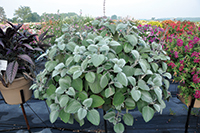
|
|
| 13
|
‘Silver Shield’ plectranthus (13) is a foliage plant that is indestructible and quite vigorous. It features nice, silver-coloured leaves and is outstanding in large containers or when grown in gallon pots for large bed landscapes. I have seen large landscapes of strictly different foliage colours and no flowers that look very nice. The nice thing about such combinations is that there is no concern about flowering time.
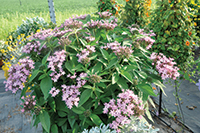
|
|
| 14
|
‘Northern Lights’ (14) is a heat-loving plant, much like all other pentas. I like pentas because I like hummingbirds, and pentas are magnets for them. Pentas has a very nice flower that lasts the whole season, and it thrives in warmer temperatures. Grow it in large containers, mix it with other cultivars that hummingbirds like or place it in gallon containers for landscape plantings.
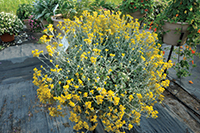
|
|
| 15
|
‘Flambe Yellow’ chrysocephalum (15) is a plant that combines wonderfully silvery leaves and nice yellow flowers. It makes a nice large planter that never needs deadheading and can be used in combinations, where it is guaranteed to add beauty.
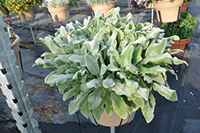
|
|
| 16
|
‘Silver Carpet’ stachys (16) has silvery greenish supper soft leaves that you cannot pass by without touching. Stachys is a plant that will attract different customers. It is a plant that you either love or hate. It is easy to grow and gets better with age. It is good in large stand-alone containers or in gallon pots for landscape plantings.
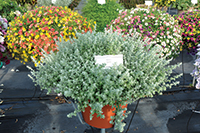
|
|
| 17
|
‘Silver Mist’ helichrysum (17) is a great filler from seed that does not take over mixed containers but enhances them. It is economical, clean and easy to produce.
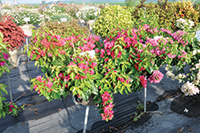
|
|
| 18
|
‘Vera Lynn’ (18) is one of three colours of bougainvillea that we had in our trials. Bougainvillea is a tough plant that can stand some drought, but it will give a better show if it doesn’t dry out too much. Bougainvillea flowers in cycles but flowers for a long time. Pruning a few branches every two weeks will keep the plant in a continuous flowering mode. Bougainvillea is excellent in large containers and landscapes.
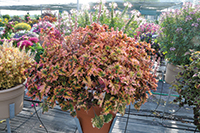
|
|
| 19
|
‘Smallwood Driveway’ coleus (19) has a moderately vigorous growing habit and very nice tapestry of colour. Coleus is excellent in large pots, combinations and landscapes. It is economical to grow. Give coleus the right timing so you don’t have to treat it with growth regulators.
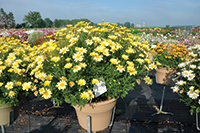
|
|
| 20
|
‘Butterfly Yellow’ (20) is the oldest argyranthemum on the market and the best one in garden performance. It is good in large combinations and profitable to produce in one-gallon containers for landscapes. One cutting of argyranthemum per gallon is sufficient to ensure a full pot. Do not plant too early because Butterfly needs more foot-candles to flower compared to other varieties. Planting a little later in the season will ensure it flowers at a much better ratio between the vegetative and flowering stages without any application of growth regulators.
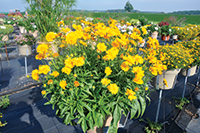
|
|
| 21
|
‘Santa Fe Yellow’ (21) is an early flowering coreopsis that does not need any vernalization. It flowers the whole summer long, and neither hot nor cold will hinder its flower power. It is excellent in large pots or in gallons for landscape plantings. Did you ever think of perennial mixes?
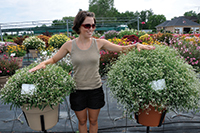
|
|
| 22
|
‘Breathless, Blush & White’ (22) is excellent in large pots and in mixes, but use it sparingly in mixes because the skinny small cuttings grow large in no time. The slowest-growing euphorbia is still vigorous compared to other genuses. You want euphorbia to enhance your combinations and not to take over. Flower shattering is still a problem during greenhouse production.
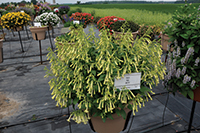
|
|
| 23
|
‘Pheeges Lemon Frost’ phygelius (23) is easy to produce. It holds its flowers for a long time and does not need deadheading. Try a few if you are looking for something that you do not see every day.
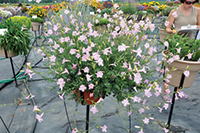
|
|
| 24
|
‘Cheron Pink’ incarvillea (24) is a plant that if it could talk would describe itself as the Born Free plant. ‘Cheron Pink’ grows fast and is full of blooms that last a very long time – you will never see this plant without any colour. This is another plant you don’t see very often and is easy to produce. It is colourful and has excellent garden performance.
Remember, if you have never grown any of these varieties before, just use a low percentage of your production to evaluate it in terms of production issues and consumer appeal. You can then decide to increase production or drop it entirely.
The trial pictures will be posted on my website at sawayagardentrials.ca .
Melhem Sawaya of Focus Greenhouse Management is a consultant and research coordinator to the horticultural industry. Comments on this or any other article are always welcome; please e-mail mel@focusgreenhousemanagement.com, or visit www.focusgreenhousemanagement.com.
Print this page